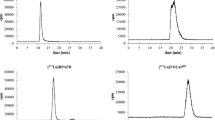Abstract.
Copper-64 (T 1/2=12.7 h; β+: 0.653 MeV, 17.4%; β–: 0.578 MeV, 39%) is produced in a biomedical cyclotron and has applications in both imaging and therapy. Macrocyclic chelators are widely used as bifunctional chelators to bind copper radionuclides to antibodies and peptides owing to their relatively high kinetic stability. In this paper, we evaluated three tetraaza macrocyclic ligands with two, three, and four pendant methanephosphonate functional groups. DO2P [1,4,7,10-tetraazacyclododecane-1,7-di(methanephosphonic acid)], DO3P [1,4,7,10-tetraazacyclododecane-1,4,7-tri(methanephosphonic acid)], and DOTP [1,4,7,10-tetraazacyclododecane-1,4,7,10-tetra(methanephosphonic acid)] were all radiolabeled with 64Cu in high radiochemical yields. Copper-64-labeled DO2P and DOTP were highly stable in rat serum out to 24 h, while 64Cu-DO3P remained 73% intact, with the remainder possibly forming a 64Cu.2DO3P dimer by 24 h. The biodistribution experiments were performed in normal Sprague-Dawley rats. Of the three complexes, 64Cu-DO2P demonstrated the most optimal clearance through the blood and liver. Copper-64-DO3P and 64Cu-DOTP exhibited higher liver uptake and longer retention of liver activity, possibly because of the large negative charge of the complexes under physiological conditions. All three 64Cu-labeled complexes showed high accumulation in bone, likely due to the binding of the methanephosphonate groups to hydroxyapatite. These results suggest that this series of methanephosphonate macrocyclic ligands may be useful as potential bone-imaging agents. The thermodynamic stability constants of the Cu(II) complexes with these three ligands were determined, and were found to be significantly higher than those of their acetate analogues. The Cu(II)-DO2P complex exhibited the highest stability constant among divalent transition metal ion DO2P complexes. Metabolism studies of 64Cu-DO2P in rat liver suggest that the DO2P ligand may be used as a bifunctional chelator for copper radionuclides in radiodiagnostic or radiotherapeutic studies. Electronic supplementary material is available if you access this article at http://dx.doi.org/10.1007/s00775-002-0408-5. On that page (frame on the left side), a link takes you directly to the supplementary material.
Similar content being viewed by others
Author information
Authors and Affiliations
Additional information
Electronic Publication
Rights and permissions
About this article
Cite this article
Sun, X., Wuest, M., Kovacs, Z. et al. In vivo behavior of copper-64-labeled methanephosphonate tetraaza macrocyclic ligands. J Biol Inorg Chem 8, 217–225 (2003). https://doi.org/10.1007/s00775-002-0408-5
Received:
Accepted:
Issue Date:
DOI: https://doi.org/10.1007/s00775-002-0408-5




